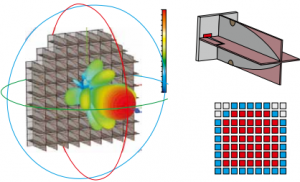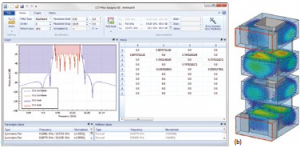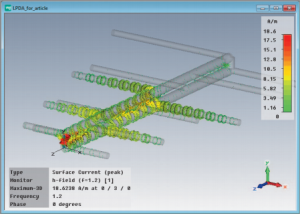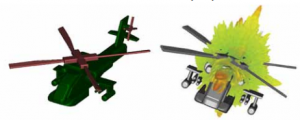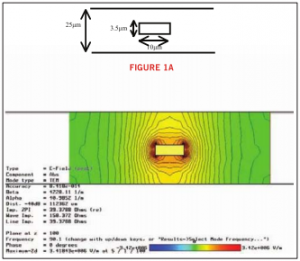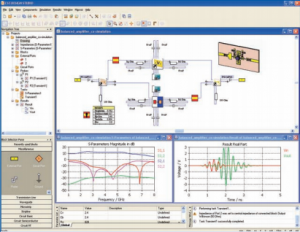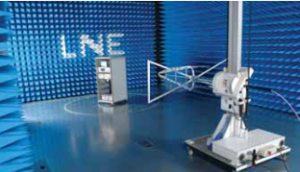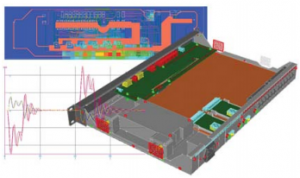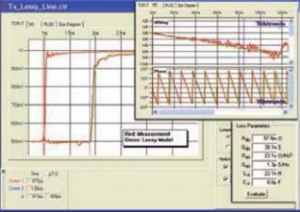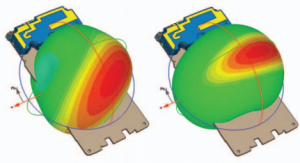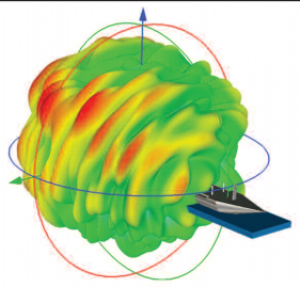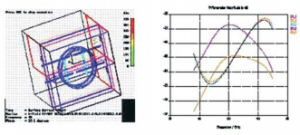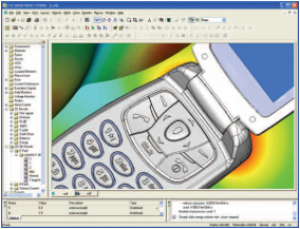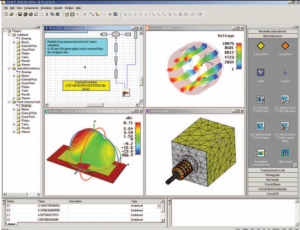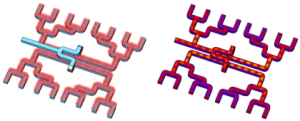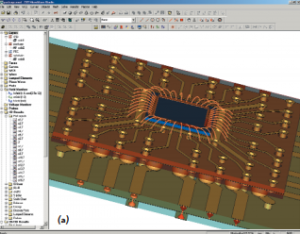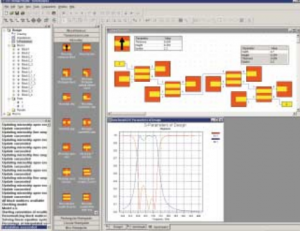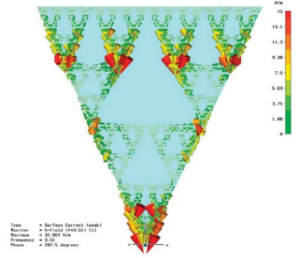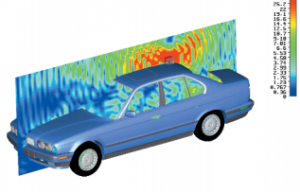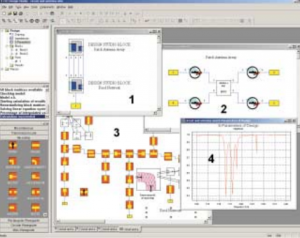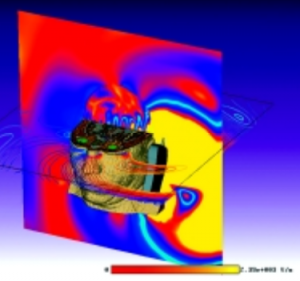Это старая версия документа!
Дополнительные материалы по программному обеспечению CST
Особенности конструкции телеметрического передатчика сантиметрового диапазона
СВЧ-электроника 2018'3
Предложена конструкция беспроводного передатчика телеметрической информации, которая позволяет передавать данные на расстояние до 60 км. Эта система использует сантиметровый радиочастотный диапазон (СВЧ), передача данных осуществляется BPSK-модуляцией. Конструкция передатчика включает модули обработки и усиления с посекционной техникой экранирования СВЧ. Передатчик оснащен цифровыми каналами через интерфейсы UART, CAN и Ethernet.
Технология ЭМ-моделирования крупных СВЧ-систем без использования суперкомпьютеров
Сергей Топорков, Электроника-СВЧ 2016'1
В статье рассмотрен способ модульного подхода к оптимизации усиления рефлекторной антенной системы, реализуемый с помощью технологии моделирования и сборки составных проектов System Assembly and Modelling пакета программ CST STUDIO SUITE. Представлено сравнение полученных результатов с параметрами полной модели. Точность модульного решения та же, что и в случае электромагнитного 3D-моделирования полной системы, а затраты вычислительных ресурсов и общее время вычисления в несколько раз ниже.
CST STUDIO SUITE 2017 Offers EM Simulation on Every Scale
EM simulation reduces costs and design time, enabling users to analyze and improve the performance and compliance of components and systems from the earliest stages of design. CST STUDIO SUITE® 2017, the upcoming* release of the EM and multiphysics simulation package, introduces new features that extend the software’s range of applications. These features include both front-end and back-end improvements across the suite, with many focusing on tools for synthesizing and simulating components, as well as for managing and analyzing these components as systems.
Автоматизация процесса проектирования антенн и устройств СВЧ в современных программных комплексах электродинамического моделирования. Часть 2. Особенности моделирования ЛПВА в среде CST Microwave Studio
Андрей Пластиков, СОЭЛ 2012'4
На примере логопериодической вибраторной антенны дециметрового диапазона волн рассмотрен процесс создания модели в программе Microwave Studio с помощью макроса на языке VBA. Выполнено сравнение результатов расчёта модели методом конечных разностей во временной области с характеристиками, полученными в среде EDITFEKO.
Школа проектирования СВЧ устройств в CST STUDIO SUITE
Международный журнал экспериментального образования 2015'8
Учебное пособие посвящено программе CST STUDIO SUITE, которая по праву завоевала большую популярность среди коммерческих программ, предназначенных для проектирования СВЧ структур. С появлением разнообразных программ электродинамического моделирования изменилось отношение к аналитическим расчетам. Ведь для реальных комплексных СВЧ устройств достаточно сложно получить аналитическое решение задачи анализа, а зачастую это просто не представляется возможным. Однако всё это не должно изменить отношения к обязательному знанию радиотехники, в частности – электродинамики, антенн и устройств СВЧ и смежных с ними дисциплин. Учебное пособие предназначено для студентов и аспирантов, обучающихся по направлению 210400 «Радиотехника» и инженерно-технических работников. Современное проектирование СВЧ структур произвольной формы остро ставит задачу описания, выбора и подтверждения достоверности модели. Построение достоверной модели связано с задачей расчета и анализа характеристик физической системы, реализуемой на этом устройстве. Это первый важный вопрос, решаемый в процессе проектирования.
Modeling Conductor Surface Roughness
Printed Circuit Design & Fab 2008'10
In high speed digital intercormectss signal attenuation is a result of both dielectric losses and conductor losses. Many articles have shown in detail the characterization and modeling efforts related to the impact of dielectric loss in PCBs and the differences between various dielectric materials1. Nevertheless, high-speed characterization modeling efforts do not often take into accoWlt the variations in conductor losses due to copper foil roughness or treatments made to the copper foil to promote adhesion. Two types of interconnect structures are mainly used in order to propagate signals in integrated circuits (ICs) and printed circuit boards (PCBs): microstripline and stripline. Stripline is constructed by sandwiching a metallic strip within a dielectric material. The benefit of the closed structures compared to the microstripline, is better protection against external signals and unwanted radiation.
True Transient 3D EM/Circuit Co-Simulation Using CST STUDIO SUITE
Microwave Product Digest 2008'10
Today’s engineers are increasingly confronted with simulation tasks that involve the simulation of two types of problems: 3D electromagnetic structures and electronic circuits. The combination of these problems is commonly referred to as EM / circuit cosimulation. Not only can a distinction be made between the methods used to perform a cosimulation, but also in the type of co-simulations available. The need for co-simulation can be seen in many application areas such as antenna design, filter tuning, UWB applications, PCB and signal integrity analysis, RFIDs, etc.
Efficient, Accurate, Reliable Em Simulation Tool
MWJ 2008'10
In the ongoing race for reduced design costs and faster time to market, simulation efficiency remains the most important factor in electromagnetic field analysis. Simulation efficiency can be determined by the time taken to reach the final design, which is strongly influenced by the level of workflow integration, the versatility in manipulating the model, the choice of solver type, the method’s accuracy, the implementation’s efficiency and, of course, the hardware speed. The new CST STUDIO SUITE™ 2009, incorporating the CST MICROWAVE STUDIO® (CST MWS) 3D electromagnetic field simulator for microwaves and RF, has been specifically designed to meet these requirements.
New Wall Modeling Method Substantially Reduces Time Required for Electromagnetic Simulation of Semi-Anechoic Chamber
IEEE EMC Society Newsletter 2008'7
Modeling of the absorber on the walls provides a major obstacle in performing electromagnetic simulation of semi-anechoic chambers due to the very high permittivities and permeabilities. Simulation is critical in designing these chambers because nearfield effects in the 30 to 200 MHz range cannot be determined by theoretical methods. The simulation model typically requires a very fine mesh in the area of the wall in order to accurately simulate the performance of an Open Area Test Site (OATS). The fineness of the mesh drives up simulation times, typically to the range of several months, delaying the design process
Choosing Software for EMC Simulation
EMC Journal 2008'5
Designing electronic products to meet EMC requirements is becoming more and more challenging. Faster clock speeds and lower operating voltages are leading to enhanced emissions via apertures and seams, from heat sinks as well as an increase in the susceptibility of products. In addition, the trend towards integrating multiple wireless capabilities into products makes it necessary to also deal with the electromagnetic interference (EMI) effects of intentional radiators.
SPICE Modeling from an EM Simulation Environment
Printed Circuit Design & Fab 2008'2
The use of full-wave electromagnetic modeling can simulate the behavior of a high-speed differential backplane channel and advance the systemlevel design process. The operating frequency of high-speed copper backplane serial links is expected to reach 10 Gbps in the next few years. At a 10 Gbps data rate, the clock frequency is 5 GHz, equating to a period of 200 ps, which results in a signal rise time in the range of 30 to 50 ps. 'This rise time will influence the analog bandwidth and the highest significant frequency component both for the measurement bandwidth and the bandwidth of the channel model. To effectively design a serial link (channel) to operate effectively at this bandwidth, accurate signal integrity modeling is required.
Simulating the ESD Measurement for High Value Feedback
Electronic Environment 2008'1
Simulating EMC performance using 3D EM modelling software in the time domain has advantages over frequency domain modelling because a wide frequency band is simulated in one run. However some phenomena like ESD, lightning strikes, EMP or other transient phenomena can only be simulated in the time domain. The TLM-TD method can be used to simulate a model of an ESD gun for analysing induced currents on wires and visualising the discharge current path on electronic equipment. The main benefit of performing an ESD simulation is that it gives results which could otherwise be difficult or even impossible to measure. It is also a very quick simulation to perform. In this paper examples of using the ESD gun simulator to mimic measurement setups and address real design problems at an early stage are presented.
Electromagnetic Simulation Of Mobile Phone Antenna Performance
MWJ 2008'1
The telecommunications sector is making great advances aimed at delivering an even stream of high-tech devices, covering the significant consumer demands in this sector. Electromagnetic (EM) simulation is becoming an increasingly important tool in the design flow, not only at the antenna level but also at the phone and environmental levels. This article compares simulated results with measurements for several steps in the phone design chain.
Predicting Probable Cavity Resonance with a 3D EM Tool
HFE 2008'1
Electromagnetic analysis can be used to predict resonances inside microwave modules, allowing the designer to implement measures to avoid poor performance and instability. Cavity resonance is commonly encountered when the PCBs and RF components are placed in an enclosure. Due to the module height and the housing structure, the standing wave with characteristic such that the E and H fields are 90° out of phase with each other. The impedance will therefore fluctuate wildly across the cavity causing unknown effects on circuitry, including the introduction of instability to active devices [1].
A Software Suite To Aid Workflow
MWJ 2007'10
All companies need to see increasing income year on year to please investors and to fund their growth. A mounting need for microwave design, combined with skilled worker shortages, make seamless growth challenging. As a result, engineers in rapidly growing companies are faced with increased workloads, more diverse work and the requirement to work with other, perhaps unfamiliar parts of the company to achieve design goals. To make growth easier to manage, seamless workflow between software design tools has become critical. For example, different departments in a company, which may be geographically separated, could be designing handset antennas, PCB layout, antenna drive circuits and interconnects. They may all need to communicate layout, circuit and EM data and, due to mergers, they may all have different tool vendors. So, how does a company ensure that an overstretched engineer does not have to redesign the wheel every time he works on a new or updated design?
An Integral Equation Solver
MWJ 2007'8
Research and development engineers working in aerospace and defense continually strive to extend the boundaries of what is technically possible and this extends to the specialized field of electromagnetic simulation technology. One branch in this community deals with the optimization of radar cross sections (RCS), while another concentrates on the influence of the surroundings (an airplane body on the performance of communication or radar antennas, for example). What both of these application areas have in common is the size of the electrical problem, which can typically run to many hundreds of wavelengths, and that the relevant structures are mainly surfaces and free space.
Suppression of Simultaneous Switching Noise in Power and Ground Plane Pairs
Conformitys 2007'6
Parallel plate waveguide (PPW) noise, also known as simultaneous switching noise (SSN) or ground bounce noise (GBN) is one of the major concerns for the highspeed digital computer systems with fast edge rates, high clock frequencies, and low voltage levels. The resonance modes between the power and ground (PWR/GND) planes excited by the SSN causes significant signal integrity (SI) problems and electromagnetic interference (EMI) issues for the high-speed circuits. Therefore the elimination of this noise is essential. Adding decoupling capacitors to create a low impedance path between PWR/GND planes is a typical way to suppress SSN [1]. However, in general, these capacitors are not effective at frequencies higher than 600 MHz due to their finite lead inductance. The embedded capacitance with a very thin dielectric is another possible solution to suppress SSN; nevertheless the electromagnetic waves still propagate between the planes with resonance at specific frequencies.
Micromachining Concept on GaAs and a mm-Wave Oscillator Example
HFE 2006'10
Micromachining can place cavities, slots, microstrip lines, air gaps and other mechanical structures directly onto the semiconductor substrate material. Present technology demands reduced manufacturing cost, size, weight and improved performance for wireless and location services exploitation like GPS, as well as for the millimeter wave devices. This kind of demand for wider bandwidth along with state-of-theart performance can be accomplished with the use of micromachining and MEMS technology [1]. Developing micromachined technology is also essential for the future of integrating the entire communication system on a single chip.
Computational Electromagnetic Rises To The Challenge
MWJ 2006'8
Unlike other numerical simulation areaslike stress or thermal analysis, high frequency computational electromagnetics is an evolving science. Experts still argue about the fastest and most elegant approaches to solving problems and no single method has emerged as an outright winner. To make headway, development teams have to invest time and money in pure research projects with all the associated risk and potential reward that this brings. With a trend towards larger and ever more complex designs, the potential reward for the end-user is the ability to solve previously intractable problems quickly and accurately.
A Software Suite With Total Synergy
MWJ 2006'1
Design engineers currently using CST MICROWAVE STUDIO (CST MWS) appreciate its ease-of-use and the insight into devices which together facilitate a significant augmentation of throughput. Now though, these customers may be taken by surprise, because the box containing the eagerly awaited and much publicized new release is titled CST STUDIO SUITE 2006. Closer inspection reveals that this suite comprises the high frequency simulator CST MWS, the block schematic tool CST DESIGN STUDIO (CST DS), the low frequency simulator CST EM STUDIO (CST EMS), and last but not least, CST PARTICLE STUDIO (CST PS) dedicated to the fully consistent 3D simulation of free moving charged particles in electromagnetic fields. Figure 1 shows the CST STUDIO SUITE 2006 interface.
A Study of Transition Effects in Supercomponents
MWJ 2005'2
Highly dense supercomponents are the basic building blocks of every modern radar, EW or military communication systems. The demand for lower volume, lower weight and increased function has spurred developers to integrate more open-carrier devices within the same supercomponent. The carrier-to-carrier transition has a major effect on channel-to-channel isolation and performance. This article is a study of the effects of two major carrier-to-carrier transition types: microstrip and grounded coplanar waveguide. Ground regime design rules are concluded from the results.
CST Microwave Studio 5.0
Chip News 2004'4 (EDA Expert #7)
Немецкая компания CST, специализирующаяся в области электродинамического анализа, продолжает развивать свою линейку программных продуктов. В конце прошлого года немецкая компания Computer Simulation Technologies выпустила новую версию своего пакета полного трехмерного электромагнитного анализа CST Microwave Studio 5.0, призванного максимально сократить время проектирования объемных СВЧ устройств и повысить достоверность результатов анализа. В основе программных продуктов лежит общий теоретических подход, позволяющий реализовать широкий набор приложений, начиная с анализа статических и низкочастотных электромагнитных полей (в программе CST EM STUDIO) до сверхвысокочастотных и оптических систем.
From Design to Reality
MWJ 2004'1
Development speed is a major concern in today’s products’ life cycle. Ranking alongside the raw costs involved with prototyping a device, time-to-market is the one key constraint imposed on design engineers. Consequently, any innovative or competitive advantage can easily be lost if advanced ideas get stuck in a long pipeline of reiterations before finally becoming a marketable product. In an increasing number of disciplines, full 3D electromagnetic field simulation is becoming the sine qua non, to advance the prototyping, virtually, to a stage where the realization does not unexpectedly deviate from expectations. In many respects, a simulation is much more informative than a prototype, as it grants unlimited insight into the mechanism that makes a device succeed or fail.
Integration allows designers to use best-in-class software
Wireless Europe 2003'4
Circuit designers are using an increasingly diverse set of simulation tools. Martin Timm argues that the industry must develop open architectures that allow users to combine programs from various vendors. Simulation tools are an indispensable part of the radio frequency (RF) and microwave systems design process. The optimization of virtual design prototypes reduces the number of «cut and try» iterations - in which real prototype devices are built and tested - thereby saving time and money. Today's wireless equipment designers need a range of simulation software that offers maximum versatility and accuracy. Although some software vendors have responded by developing all-in-one packages, in practice designers rely on the combined expertise of several companies.
Packing More Antenna into Available Space
Applied Microwave & Wireless 2002'10
Wireless applications, particularly with multiple resonances, put new demands on antennas pertaining to size, gain, efficiency, bandwidth, and more. One promising approach in this regard is to use fractal geometries to find the best distribution of currents within a volume to meet a particular design goal. Within this world of complex geometries, engineers need the most efficient method using the most effective tool. CST MICROWAVE STUDIO® (CST MWS) from Computer Simulation Technology is a timedomain tool capable of analyzing broad-band structures with multiple resonances. It was used to study these fractal geometries using the example of a Sierpinski Triangle Antenna. The simulation demonstrated the ability of CST MWS to match the measured response of this broadband device in a single simulation, while also providing control over complex geometry construction with the built-in VBA macro editor.
A Revolution In Time Domain
MWJ 2002'8
CST MICROWAVE STUDIO® Version 4 (CST MWS) is a major new release of the company’s flagship 3D EM microwave modeling and design package. Over 1400 changes, enhancements and new features have been added to make this already powerful tool truly comprehensive and an invaluable resource. The microwave design engineer seeking rapid evaluations and optimizations of his virtual prototypes can now find a complete solution in a software tool that, despite its new power, has remained as user friendly and fun to use as ever.
Open Architecture Solves Large 3D Puzzles
MW&RF 2002'5
Version 2.0 of CST’s Design Studio modeling environment allows the seamless interaction of any number of solvers and simulation tools, as well as models and test data. Higher speeds and increasingly complex designs are blurring traditional boundaries between system modeling approaches. Complex computations are often best-solved by breaking them into a series of related, smaller problems. That is the approach used in Version 2.0 of the CST Design Studio (CST DS) from CST (Wellesley, MA), an open design environment that allows a variety of electronic-designautomation (EDA) tools to be applied to different parts of circuit and system models. With the open environment, a design engineer is free to choose the most-appropriate solvers available, regardless of the simulation method or supplier.
Designing components containing photonic bandgap structuresusing time domain field solvers
MWEE 2002'3
Arbitrary passive 3D structures are becoming increasingly complex, requiring ever faster and more efficient field solvers. Due to economical use of computer resources and run-time, the time domain code the technique has been gaining in importance over the last few years. This paper describes the application of metallo-dielectric resonant structures at microwave frequencies incorporated into realistic devices by using a 3D field simulator based on the time domain technique.
Ощутить вселенную трехмерной
Chip News 2002'2 (EDA Expert #1)
Прогресс не стоит на месте. Прошли времена, когда полное трехмерное моделирование электромагнитных полей интересовало только специалистов в области антенн и фильтров на объемных резонаторах. Современная тенденция применения более высоких частот, а также компактность устройств вынуждает инженеров учитывать эффекты распространения волн и полей рассеяния в задачах, которые ранее решались только традиционными средствами моделирования схем. Программный пакет CST Microwave Studio версии 3.4 производства немецкой компании Computer Simulation Technology является самой современной системой трехмерного электромагнитного моделирования. Великолепная комбинация интуитивного пользовательского интерфейса, мощных функций построения полностью параметризованных геометрических моделей и чрезвычайно производительного вычислительного ядра позволяет значительно ускорить процесс проектирования и сократить время выхода изделия на рынок. В данной статье приведен подробный обзор возможностей пакета CST MWS и его новых функций.

